St Paul's Anglican Church
Manuka
First organ, see: Canberra. St Luke's Anglican Church, Deakin.
Present organ, B. 1972-74 A. Welby. 3m., 19 sp.st., 6c., el.pn.
Gt: 8.8.4.2-2/3.2.1-1/3. Sw: 8.8.4.2.1.II.8. Ch: 8.8.4. Ped: 16.8.4.
Many electronic stops were added to the organ in 2001
Choir organ
Built by J.W. Walker & Son, Ruislip, Middlesex, UK 1961
for St Cuthbert's Anglican Church, Carlton South (Sydney)
Relocated to Manuka by Ian Brown & Associates, March 2017
2 manuals, 3 ranks extended plus mixture, electro-magnetic action
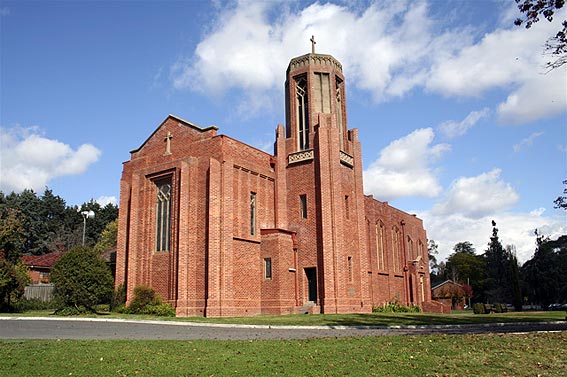
From SOJ Autumn 2002:
THE COMBINATION ORGAN ARRIVES IN AUSTRALIA
by Christopher Erskine
Organist, St Paul's Anglican Church, Manuka ACT
The combination organ - part electronic, part pipe - has finally arrived in Australia. Although relatively common in the USA, the new installation at St Paul's Anglican Church in Manuka, ACT, is believed to be the first significant combination organ in Australia with both pipe and electronic ranks working together in the one instrument. It has 24 pipe stops and 34 electronic, for a total of 57 stops (one stop contains both an electronic and a pipe rank).
The Manuka organ is a good example of how the two types of organ can work well together. The original pipe organ is a mongrel installation of variable musical worth. The electronic additions have transformed it into a fine organ of surprising range and versatility.
But St Paul's Manuka is a significant church in the Anglican communion, the largest Anglican church in the national capital, with a good reputation for liturgy and church music. What prompted such a church to take such a controversial step?

THE FIRST ORGAN IN ST PAUL'S
St Paul's was the first Anglican church built in the national capital after Canberra's establishment in 1911 (the beautiful village church of St John's long predates the establishment of Canberra). The foundation stone was laid by the Governor General in 1938. By 1939 the stubby nave, as high as it was long, had been built.
Work resumed in the 1950s with the building of the sanctuary and tower. The sanctuary, separated from the nave by an enormous and somewhat incongruous brick arch, also contained a chancel with divided choir stalls in the traditional Anglican layout. Above the choir stalls on each side were platforms for the eventual erection of a fine pipe organ.
In the early 1960s John Barrett became organist and choirmaster. He set about putting that pipe organ together. A new organ was far beyond the financial reach of the parish. With the help of organ builder Anthony Welby he scoured the countryside for discarded ranks from organs being rebuilt or demolished. Legend says that one rank was found on a rubbish tip, while another rank in the organ comes from no less than three previous organs.
By 1972 he had enough pipes and the necessary blowers and chests to inaugurate a small three manual pipe organ. It had just one mixture, an intriguing but not very useful Terzian II (1 3/5 and 1 1/3) on the Swell. The Great organ had both a Nazard and a Larigot, but no Mixture, giving it a very quinty sound. The unenclosed Choir organ had no mutations and an enormously powerful Trumpet that could never be used as a chorus stop. The Pedal organ was woefully inadequate, with a single unit rank of stopped flutes, and an 8' Cello doing duty as a temporary substitute for a Pedal Principal.
John Barrett envisaged that the organ would grow over time, so he was content with what had been installed. Its deficiencies would be cured one by one, and eventually a fine organ would emerge.
Alas, the installation lasted barely more than a decade, thanks to massive water damage and changes in liturgical practice.
The poor roof design in the sanctuary led to regular overflows of rainwater down the walls. For some time in the 1980s a bucket was placed next to the console to catch the water as it flowed down the wall, trickled through all parts of the Choir organ. and then finally dripped steadily into the bucket. Similar damage occurred on the other side of the organ which contained the Great, Swell and Pedal. By the time I became organist in 1986 water damage had made the Choir Trumpet just about unplayable, and caused large sections of the organ to be erratic in their operation.
As well, liturgical changes after John Barrett's death in 1981 had brought about a major re-arrangement of the church furniture. The altar was moved into the middle of the chancel, and the choir stalls were removed. For several years I had to accompany the choir, which was sitting in the back pews of the nave, from the console in the sanctuary. The conductor had to stand in the side aisle to see me, and the whole arrangement was obviously impossible in the long term.
After a lot of debate the congregation agreed to move the organ into a new choir gallery at the back of the church. The front of the gallery used the old frontals from the choir stalls in the chancel, giving the gallery a substantial feeling of connection with the original layout. The organ was to be repaired and re-erected in a new case in the gallery. Significantly the case would have its own roof. If the church ever leaked again, at least the organ would remain dry!
There was some debate about whether the original organ was worth salvaging. Some argued in favour of a new purpose built two manual organ. But others, including me, took the longer view that a workable nucleus of a three-manual organ could be produced from the original pipes. An organ in a growing and developing church is very much a work in progress. Over time it will be expanded and developed with the church, and it would be wrong to think that what was built in 1989 would remain in that form for ever.
Peter Jewkes was given the contract to restore and re-erect the organ. Some pipes were altered from the Barrett specification. For example, the Great Larigot became a rather more useful Choir Tierce. The Swell Cornopean was returned to its original form as an Oboe, with space left at the back of the Swellbox for a Trumpet unit rank playable at 16', 8' and 4' on both Swell and Pedal. The Swell Terzian was rebuilt into a more conventional Mixture II of octaves and fifths, while a new Mixture III crowned the Great principal chorus. The damage to the Choir Trumpet was so bad that it was unsalvageable. But at long last the Pedal Open Wood could be installed. It had been sitting under the church hall for many years, not installed lest it suffer the same water damage as the rest of the organ.
The result was remarkable. It is a tribute to Peter's skill that he was able to take the most unpromising raw materials and produce a reasonable pipe organ. It was never going to win a prize as the most beautiful sounding instrument in Australia. But it was more than adequate for the task, and over time could be augmented and refined to turn it into something quite impressive. Given the mongrel ancestry of the pipes, it was astonishing that such a coherent instrument could emerge, and Peter deserves an award for what he was able to achieve given what we gave him to work with.
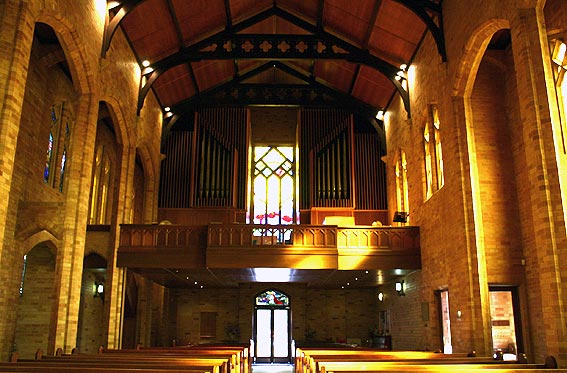
This is the specification as it stood during the 1990s.
| GREAT Open Diapason Gemshorn Principal Rohr Flute Octave Mixture SWELL Gedackt Gamba Celestes Principal Octave Mixture Oboe CHOIR (unenclosed) Stopt Diapason Spitzflute Nazard Fifteenth Tierce PEDAL Resultant Bass Open Wood Subbass Cello Bass Flute Octave Flute |
8 8 4 4 2 III 8 8 8 4 2 II 8 8 4 2-2/3 2 1-3/5 32 16 16 8 8 4 |
TC (from 16) (from 8) |
The deficiencies glare out at you from this specification. The lack of reeds was obvious. The Choir, though pleasant enough, was not quite a Positive and not quite an enclosed Choir. The Swell rested on inadequate foundation stops and had no 4' flute. There was not a single 2' flute in the entire organ.
Less obvious was the problem with the Great Open Diapason. The bottom 20 or so notes came from a different organ from the rest of the rank. They were of noticeably reduced scale, and the stop dropped off in power as you went down the keyboard.
This caused a major flow-on problem to the Pedal. The Open Wood depended on having a strong 8' Diapason to supplement it. But it was precisely in the pedal registers that the Open Diapason dropped off in power. The Open Wood was therefore unable to support the Great principal chorus (which was quite impressive above middle C) because the notes below middle C were too weak.
However, we laboured on, and by 1999 a donation was in place to buy the long-hoped-for Swell reed. This would be the start of the development of the Jewkes organ.
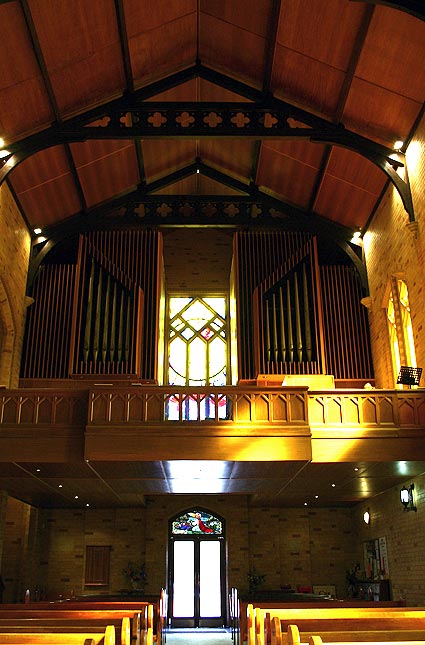
THE CHURCH EXPANDS
And then something happened that changed everything.
By 1999 it had become clear to the congregation that the building was too small to accommodate the growing numbers of worshippers in the parish. Every attempt to add seats had been insufficient. At the 10am service the church was regularly full.
As well, the role of the parish had changed. In 1938 Manuka was just a suburb, and St Paul's was envisaged as just another parish church. Across Lake Burley Griffin was historic St John's as the mother church of the city, and on the shores of the Lake would one day rise the great National Cathedral. In the meantime the diocesan cathedral would remain in the magnificent Blackett-designed St Saviour's Cathedral in Goulburn.
By 1999 all that had changed. Manuka was now part of central Canberra, which had become a far larger city than had been envisaged in 1938. St Paul's was a much bigger building than St John's, and the plans for the great National Cathedral had been abandoned, replaced by Bishop Browning's exciting vision for a National Centre for Christianity and Culture. The diocesan cathedral remained steadfastly in Goulburn, leaving something of a void for the Anglican Church in Canberra.
St Paul's was increasingly catapulted into the role of the major Anglican church for the national capital. For example, the National Memorial Service for the Thredbo disaster in 1996 was held at St Paul's, and the Queen, the Governor General, the Prime Minister and a steady flow of other important visitors came to St Paul's throughout the 1980s and 1990s.
By 1999 the parish had adopted a vision of the Church in the City, a city church for Canberra in the style of St James King St in Sydney, for example. But this vision required more seats in the church in order to be fulfilled. So two forces - a growing congregation and a changed parish vision - came together at the one time, both demanding that the building be expanded.
The only feasible way to expand was out the back. Two new bays would be built, at the same height and width as the nave, and in exactly the same architectural style since this was now a heritage-listed building. This meant demolishing the old gallery and moving the organ into a new and much bigger gallery in the extension. The result would be a 50% increase in seating for the congregation, and an increase in seating in the gallery for the choir from a squashed 20 to a very comfortable 60 or more.
The building cost of over $600,000 drained the organ fund of any donations for the foreseeable future (the existing donation for the Trumpet helped pay for the moving of the organ instead). Instead of a new Swell trumpet, we could look forward to a continuation of the same incomplete specification in a considerably larger building for many years to come.
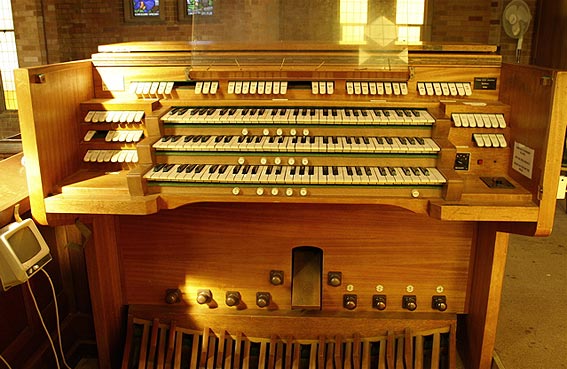
THE COMBINATION ORGAN ARRIVES
Enter Ahlborn-Galanti organs, in the person of David Pitts from the Pipeless PipeOrgan Company in Gosford. Ahlborn produces a range of four modules to add to pipe organs. These add a variety of stops depending on the module and the needs of the particular organ. Ahlborn does not synthesise their stops, but instead records real organs pipe by pipe. Together with various technical developments in speakers and amplifiers, the resulting sound is remarkable, for most people almost indistinguishable from the real thing.
Discussions took place between David and me for some time. There were many questions to answer. Not the least was: how do you keep the pipes and electronics in tune with each other? Ahlborn answered that with a tiny device the size of a thumbnail, that sensed temperature and humidity and adjusted the electronics to match the anticipated change in the pipes.
But there were other questions. Could we change the specifications on the modules, because no single module or combination of modules did all that we wanted? Yes, within reason. Could we put some manual stops on the Pedals, to give us an independent principal chorus on the Pedals? Yes. And so it went on.
When our discussions began it had been assumed that a lot of money would have to be spent converting the organ to midi so that it could work with the modules. But midway through the discussions David learned of an important new development from the USA, the pipe organ midi interface (POMI). This device converted the signals from the keyboards into midi, at substantially less cost than physically converting the entire organ to midi.
Finally the specifications were completed. Two modules were to be used, a Classic and a 202. Each would have some modifications from the original specification to suit the St Paul's organ. Almost all the deficiencies in the pipe organ were addressed, and along the way came a number of "bonus" stops - stops that would not have been ordered by themselves but which came with the modules as a package deal. These included no less than four 32' stops on the pedals, a Mixture for each division of the organ, and two 8' flutes, one for the Great and one for the Choir.
The final quote from David Pitts was received and the matter sent to Parish Council. Two donations were available to cover the installation cost. With some hesitation the Council agreed. The hesitation was because this was apparently the first such significant installation in Australia. Did we want to be pioneers?
In truth we felt we had little choice. The pipe organ could not be augmented with new pipes for years until the building work had been paid off. Yet the expanded building, and the expanded role for the church, demanded that the organ be expanded to match. The Ahlborn proposal was just about the only financially feasible way to do this, pioneering though it might be.
The building work on the church began immediately after Easter 2001. Through much of 2001 the choir was moved to the back of the altar, accompanied by a one manual Ahlborn organ playing through the church loudspeakers. Sitting in the back gallery, mute and swathed in plastic to protect it from the phenomenal amount of dust, sat the pipe organ. In early October we saw the back wall finally come down, followed by tantalising glimpses of the new organ case rising behind the old. It was a major trial for the musicians, looking at what was and what was to come, while singing and playing from almost the worst location in the entire building.
In November Peter Jewkes' firm moved in to re-erect the organ in the new and much bigger gallery. His firm was not involved in the electronic augmentation, but they had the essential task of putting the pipe organ into its new home. On the first Sunday in December 2001 the choir left its temporary home and processed down the nave from the altar to the new gallery, and then the pipes were sounded for the first time in over 6 months.
At once it became clear that the acoustic of the building had changed significantly. The pipe organ, once strong and supportive in the smaller building, was struggling somewhat in the extended structure.
Four days later, David Pitts arrived with his electronic equipment. Ten huge loud speakers were manhandled into the organ case. Each division of the organ has its own pair of speakers, allowing not only stereo separation but a recreation of the divided windchests of the pipe organ. The Swell speakers are installed inside the Swellbox, making them susceptible to the Swell shutters along with the Swell pipes. The Pedal organ scores four speakers: two for the higher notes, and two large subwoofers facing backwards for the formidable array of 32' stops.
By contrast the modules are very small, smaller than the tower on a personal computer. The POMI sits above them, with a baffling array of wires leading from the console and out the other end of the POMI into the existing organ circuit board. The whole installation - speakers, amplifiers and circuitry - sits inside the organ case, keeping it out of the way of prying hands and worse.
It was a desperate race to install and tune the entire organ, pipes and electronics, in time for the dedication of the extension on 9 December by the Governor General and the Bishop. We had a choir of 60 in the new gallery, not to mention 6 brass and timpani. In fact I had no opportunity to do more than a cursory practice on the extended instrument before the big day. I had to work out the stop changes for Parry's massive "I was glad" at home, for example, making assumptions about the sound of the new stops that fortunately turned out to be largely accurate.

THE RESULT
But the result is incredible. The transformation of the pipe organ is beyond expectations. The pipes and electronics work together brilliantly. The best of the pipework now sounds better than ever, while the electronics add brilliance, depth and fire to the chorus. The electronic wizardry that keeps the two parts in tune with each other has worked flawlessly, despite temperature changes of well over 15C since installation in early December.
The Great Open Diapason is the only stop where one tab brings on both an electronic and a pipe rank. The electronic rank has been voiced to add depth to the bass but to taper off in the treble, giving the long-awaited oomph to the stop from top to bottom. It now acts as a very solid foundation to the Great principal chorus.
The new Swell Diapason has transformed the Swell principal chorus, too. While not as powerful as the Great, it is now a good second division, resting at last on a more substantial bass than a mere Gedackt.
The Choir Cymbale III was a stop we didn't feel we needed. However, it has added a brilliance to the Choir chorus that has enabled the Choir to become a useful foil to both the Great and the Swell.
The Swell reeds do all that one expects of a Swell reed chorus, while the Great reed chorus is extremely powerful. Indeed, with Full Great including reeds one hardly needs the Swell at all, and the sound is so strong that this combination would only be used for a big verse of a hymn on a great occasion.
On the Pedals the Violone has turned out to be one of the most useful stops of all. It blends well with the Open Wood to give definition to the 16' tone. The 32' Contra Bass can be heard rumbling below the 16' tone, and surprisingly it works extremely well with the Resultant Bass - one of the few organs anywhere which has both a real and an acoustic 32' octave playable together.
The Pedal reeds are magnificent. They are much more in the style of northern European Bombardes than the floor-shaking sounds of an English cathedral pedal organ. This scale is appropriate both for the size of the building and the size of the organ.
For the first time the organ sound comprehensively fills the church. It now bounces off the east wall and comes back at you. At Christmas the congregation in the extended nave engaged in a titanic struggle with me during "O come all ye faithful" as to who could outdo whom. Finally I put on the entire Great reed chorus and the 32' Contra Bombarde and just managed to win the contest at the end of the last verse. But it is a mark of how the congregation has responded to the sound that the overwhelming power of the expanded instrument is only just sufficient to support congregational singing at the major festivals of the church.
Meanwhile we have begun to explore those "bonus" stops that have turned out to be exquisitely beautiful. The Choir Corno di Bassetto, for example, has become a very useful solo stop for chorales and lighter organ work. The two new 8' flutes are delightful alternatives to their pipe cousins at the same pitch, while the Choir Festival Trumpet is capable of doing major trumpet solos accompanied by the Swell principal chorus.
One of the most amusing experiences is to play a chorus that consists of both pipe and electronic stops and ask organists down below in the nave to tell which is which. Nobody yet has been able to do so. The flute chorus on the Great is probably the best example. Using either the pipe or electronic 8' flute, the pipe 4' flute and the electronic 2' flute, you get a chorus where the blending is so good that one cannot tell simply by listening which rank is pipe and which is electronic.
Overall, one of the revelations is just how well modern electronic and pipe stops can sound together. It seems that electronic stops are improved when played with pipes, while the electronic stops add definition and brilliance to otherwise unimpressive pipe ranks. Sceptical organists (of which there were quite a number) have become converts.
In only one aspect did the new installation turn out to be a problem. At an early stage we had to decide how to control the extra stops from the console. I insisted on stop tabs to match the existing tabs, but it would cost more money than we had to use tabs controlled by solenoids. In the end the new stop tabs were installed to either side of the keyboards, with no solenoids to allow them to be moved up and down with the pistons.
This compromise has the virtue of honesty. An organist looking at the console sees the pipe stops in a single row across the top of the console. To either side of the keyboards are the electronic stops, enabling the organist to know precisely whether a particular stop is pipe or electronic.
But honesty is one thing: practicality is another. The compromise is unfortunate in two respects. First, each division of the organ now has stops in two locations. The Great, for examples, has pipe tabs above the Swell keyboard and electronic tabs to the right of the Great keyboard.
Second, the tabs are not controlled by the pistons, though the stops themselves are. A 5-position rotary switch is located on the right of the console, allowing 5 memory settings for the electronic stops. These settings are added to the existing settings for the pipe tabs. But the organist does not know what is on or off by looking at the tabs, but has to rely on faith that Pedal piston 4, for example, has brought on the 16' Bombarde and taken off the 32' Contrabasse.
THE FUTURE
However, taking the longer view, the console itself is probably approaching the end of its useful life. It was put together from bits and pieces in the 1970s, and its wiring, though robust, is outdated and produces a cipher from time to time. The keyboards warp in the frequent weather changes in Canberra, leading to the occasional sticking note. So a new computerised console has joined the organ "wish list" alongside replacements and augmentations for the pipes.
The commitment to the pipe organ remains. One day the Swell will acquire a reed, the Great Open Diapason will have its lower octaves replaced, and the Pedal will get an independent 8' Principal, to name but three items on the list. The St Paul's organ remains a work in progress, as it has been for 30 years.
For now it is a combination organ, and will probably remain one for a long time. But I and my successors as organists of St Paul's will continue to develop the instrument as I have done over the last 15 years. One day in the future people will listen to the organ of St Paul's and know that they have heard one of the finest and most interesting instruments in the country. I may or may not be alive to hear it, but I will know that I have made some contribution to that end.

Photos: Trevor Bunning (May 2006)
THE NEW SPECIFICATION
Here is the revised specification, with the origins of each stop. Each rank is entirely independent with the exception of the Pedal pipe stops noted below.
| GREAT 1. Montre 2. Open Diapason 3. Gemshorn 4. Holzgedackt 5. Principal 6. Rohr Flute 7. Octave 8. Block Flute 9. Mixture 10. Plein Jeu 11. Bombarde 12. Harmonic Trumpet 13. Clairon Swell to Great Choir to Great |
16 8 8 8 4 4 2 2 III IV-V 16 8 4 |
Electronic Original pipe plus Electronic Original pipe Electronic Original pipe Original pipe Original pipe Electronic Original pipe Electronic Electronic Electronic Electronic |
|
| SWELL 14. Contra Gamba 15. Diapason 16. Gedackt 17. Gamba 18. Celestes 19. Octave 20. Flute octaviante 21. Super Octave 22. Larigot 23. Mixture 24. Scharff 25. Bombarde 26. Trompette 27. Oboe 28. Tuba mirabilis 29. Clarion Tremulant Swell octave Swell unison off Swell sub octave |
16 8 8 8 8 4 4 2 1-1/3 II III 16 8 8 8 8 4 |
Electronic Electronic Original pipe Original pipe Original pipe TC Original pipe Electronic Original pipe Electronic Original pipe Electronic Electronic Electronic Original pipe Electronic Electronic |
|
| (last three couplers also operating through intermanual couplers) |
|||
| CHOIR unenclosed 30. Bourdon 31. Stopt Diapason 32. Spitz Flute 33. Nazard 34. Fifteenth 35. Tierce 36. Cymbale 37. Corno di Bassetto 38. Festival Trumpet Tremulant Swell to Choir |
8 8 4 2-2/3 2 1-3/5 III 8 8 |
Electronic Original pipe Original pipe Original pipe Original pipe Original pipe Electronic Electronic Electronic |
|
| PEDAL 39. Resultant Bass 40. Contra Basse 41. Soubasse 42. Open Wood 43. Violone 44. Sub Bass 45. Contra Gambe 46. Principal 47. Bass Flute 48. Cello 49. Octave 50. Octave Flute 51. Octave 52. Cymbale 53. Contra Bombarde 54. Contra Basson 55. Bombarde 56. Dulzian 57. Posaune Great to Pedal Swell to Pedal Choir to Pedal |
32 32 32 16 16 16 16 8 8 8 4 4 2 III 32 32 16 16 8 |
Original pipe, from 42 Electronic Electronic Original pipe Electronic Original pipe Electronic Electronic Original pipe, extended from 44 Original pipe Electronic Original pipe, extended from 47 Electronic Electronic Electronic Electronic Electronic Electronic Electronic |
|
Photos supplied by Trevor Bunning (May 2006)
From SOJ Autumn 2013:
Ian D.Brown & Associates
In his December 2012 Newsletter Ian Brown reports the installation of a Trumpets Royal stop on the organ at St Paul's Anglican Church, Manuka.
"Trumpets Royal"
This is how the stop knobs are engraved for the new horizontal Trumpet stop at St Paul's, Manuka, ACT. The recently completed work is a gift in memory of Betty Erskine, a former director of music at St Paul's church who passed away a year ago. She had a fascination with horizontal solo trumpet stops ever since seeing them on a trip to Spain many years ago. The pipes are voiced on 7 ½ inches wind. This heavy pressure is achieved by the installation of a small blower to boost the wind taken from the main supply. The tone is not thin and hard but more smooth like an English Tuba.
The Manuka Project began for us in 2009 when we built a new four manual terraced console. This is described on the church's website as one of the finest pieces of furniture in the church and has been described in the Sydney Organ Journal as a "gorgeous new console" for St Paul's. Thank you to these people for their kind comments. It was certainly a rewarding project.

Photo: Ian Brown
Starting in July this year we commenced work to build an entire new Choir Organ Division for this large composite organ. Many of the digital voices would be replaced by real pipes. We constructed a new nine-stop slider wind chest using well-seasoned red cedar and marine plywood. Electro-pneumatic action was used for the key action and the sliders are moved by Slic motors. The primary action valves of the key action are fitted with piano action jack springs and an adjusting button for spring tension. This is to adjust the mechanism for optimum performance, especially speed of repetition. The mechanism is extremely responsive. The division is now enclosed in a swell box constructed of hardboard panels veneered in Victorian ash and given several coats of hard lacquer for good sound reflecting qualities. This swell expression box is an outstanding success as it has more than adequate dynamic range. Standing on this wind chest are eight ranks of restored and new pipes plus a spare slide. The restored pipes are Cello 8', previously a pedal stop, with appropriate new pipes to complete the stop, a restored Dulciana from a Richardson organ, here used as a Vox Angelica 8', a Stopped Diapason 8' (wood) and a Spitz Flute 4' from the previous Choir organ. To these we have added new pipes for Principal 4', Principal 2', Tierce 1 3/5' and Octavin 1'. There still remain the digital stops: Nazard 2 2/3', Corno di Bassetto 8', Vox Humana8' and Tromba 8', all enclosed with heir dynamic range carefully adjusted to match the enclosed pipes.
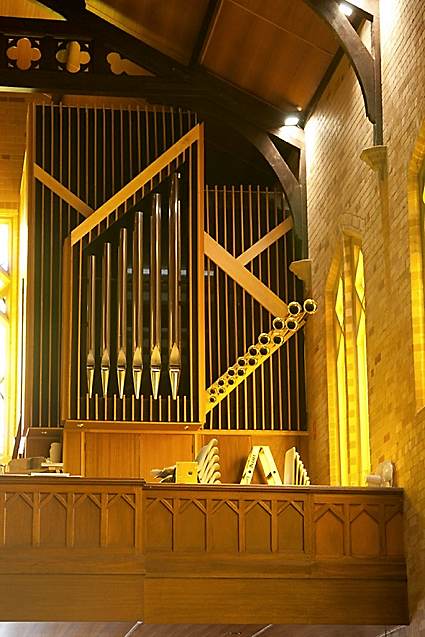
Photo: Ian Brown
"Trumpets Royal" appears as unenclosed stops on the Choir and Solo.
This organ commenced life as something put together from second-hand pipes and parts. Amongst that legacy was an Open Diapason No 1 8' on the Great with a particularly weak bottom two octaves. A completely new stop with more generous scaling provides a solid foundation on which is built a rather brilliant chorus. The lowest twelve pipes are of polished tin and are now placed in the façade. The dull grey zinc tapered Gemshorn 8' pipes have been moved from the façade and are now out of sight within the organ.
At the planning stage of the project there was much discussion with the clients about the positioning of the Trumpets. Obviously the opportunity should be taken to improve the rather plain appearance of the casework. A dominant motif in his building is the arrangement of diagonal lines in all the windows. The design by Jennifer Brown reflects these lines by placing the Trumpet pipes on a block of lighter timber (Canadian rock maple) set into the vertical timber slats at the diagonal and the simple placement of further pieces of maple diagonally at strategic points. This, together with the provision of new polished tin pipes, has resulted in a visual transformation. The Trumpet pipes were made in Yorkshire. Tin was sent to a brass instrument maker to spin the metal top form the flared ends and these were soldered on to the resonators. The effect is stunning. Reflection from the amber windows at certain times of the day make the flared ends appear to be made of gold.
Whilst the volume of the solo Trumpets is loud enough for a single pipe to be heard above full organ, the tone is not thin and harsh. It is quite smooth but still recognizable as "Trumpet" tone. What a wonderful way to announce the arrival of a bride or a bishop or to enhance a special occasion with a flourish.
This has been a rewarding project for us. Special thanks to the Revd Dr Brian Douglas and the St Paul's organists for their support and encouragement. More information and photos are on St Paul's web site.
Ian Brown
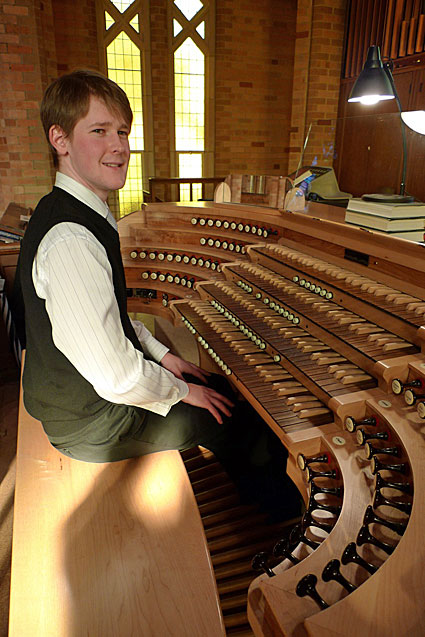
Canberra organist, James Porteus

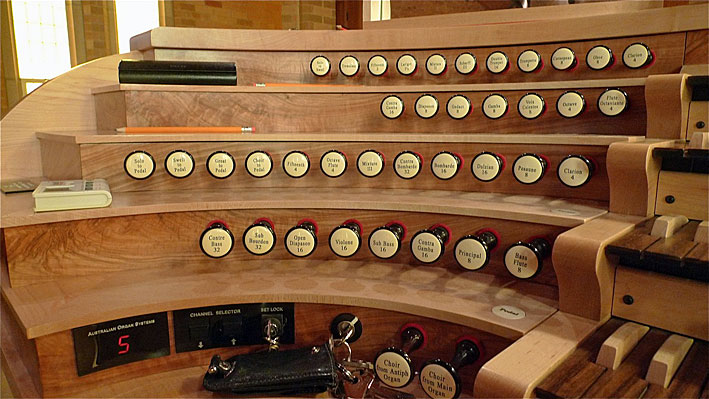
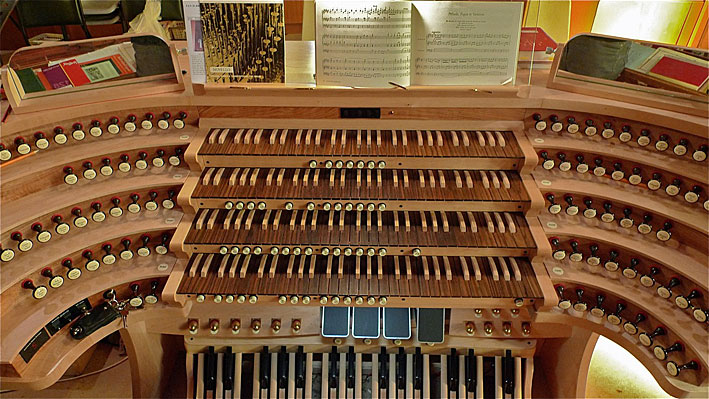
Console photos: Trevor Bunning (July 2012)
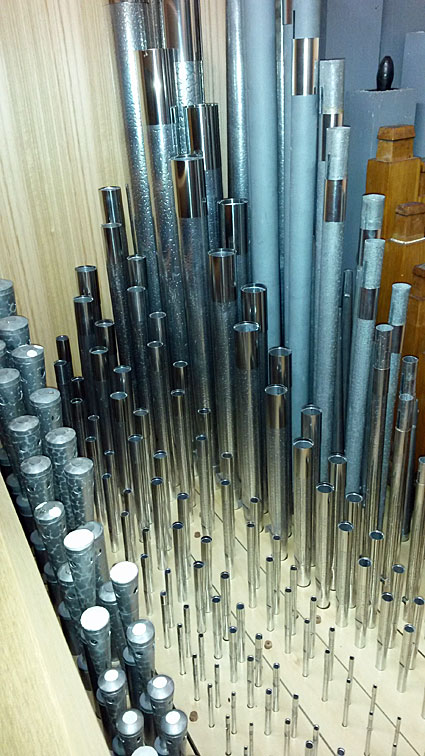
Choir division showing the new Fagottregal 16'
[Photo: Ian Brown October 2015]
Choir Organ
Built by J.W. Walker & Son, Ruislip, Middlesex, UK 1961 for St Cuthbert's Anglican Church, Carlton South (Sydney)
Relocated to Manuka by Ian Brown & Associates, March 2017
2 manuals, 3 ranks extended plus mixture, electro-magnetic action
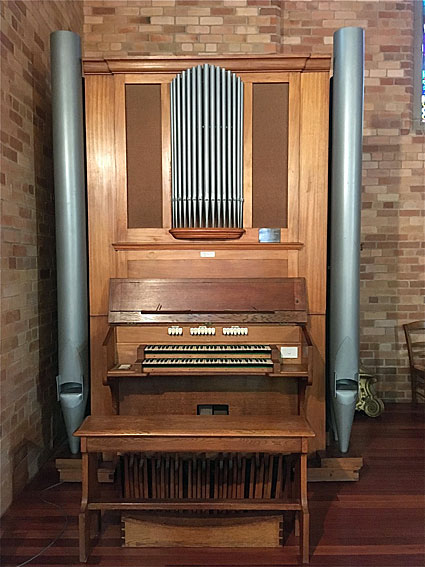
(Trevor Bunning June 2017)
From Ian Brown (March 2017):
The instrument at this church is a Walker Positive organ. It was installed in St Cuthbert's Anglican Church, Carlton South, NSW in 1961 by Arthur Jones on behalf of J.W. Walker & Son, Ruislip, Middlesex, UK. It has two manuals, three ranks and mixture extended. It was removed from the Carlton church and relocated as a choir organ at the front of St Paul's Anglican Church, Manuka by Ian Brown & Associates in March 2017. It is almost identical to the organ at St Paul's Anglican Church, Seaforth, NSW.
The specification is as follows:
| Great Open Diapason Lieblich Gedeckt Dulciana Principal Twelfth Fifteenth Mixture Swell Open Diapason Lieblich Gedeckt Dulciana Dulcet Lieblich Flute Nasard Flautino Tremulant Pedal Bourdon Bass Flute Fifteenth Octave Flute |
8 8 8 4 2-2/3 2 III 8 8 8 4 4 2-2/3 2 16 8 4 4 |
A B C A A A A B C C B B B B B A B |
Balanced Swell Pedal
Crescendo Pedal
Compass 61/30
The pipes either side are the bottom octave (stopped metal) of the
Bourdon. The three 8' stops have a grooved bass.
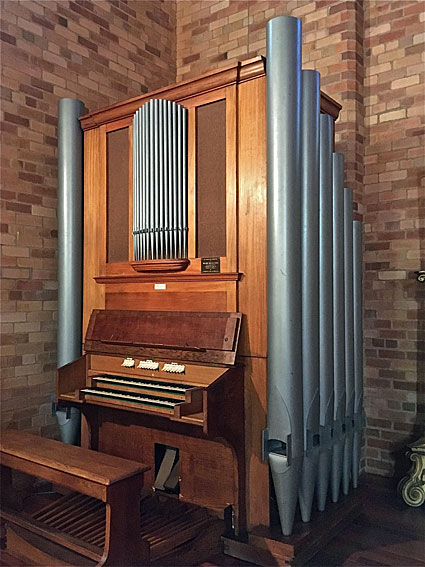
(Trevor Bunning June 2017)
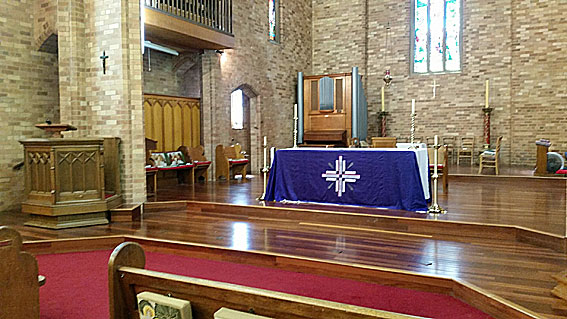
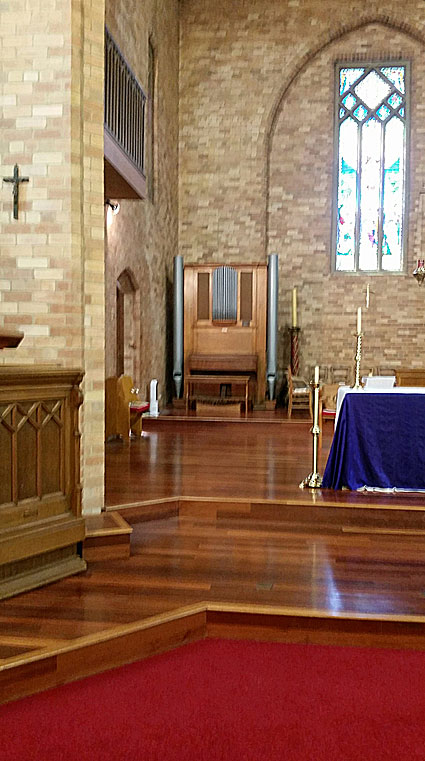
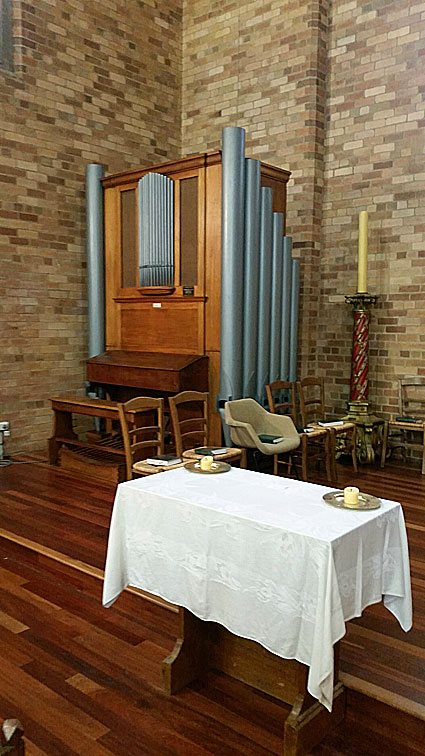
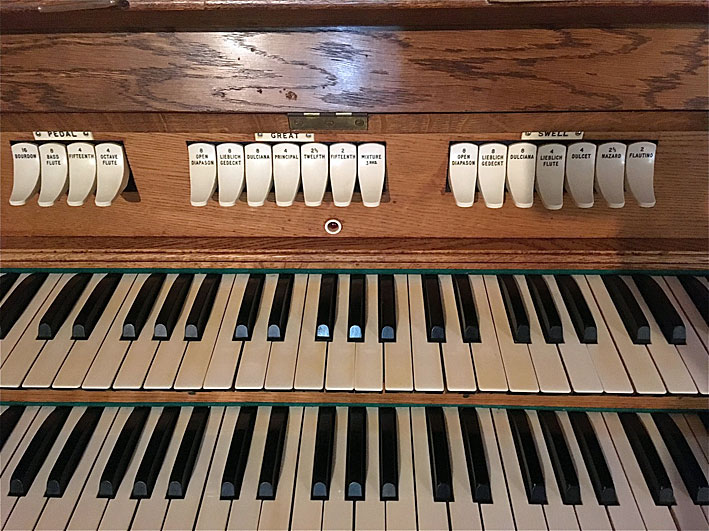
(Trevor Bunning June 2017)
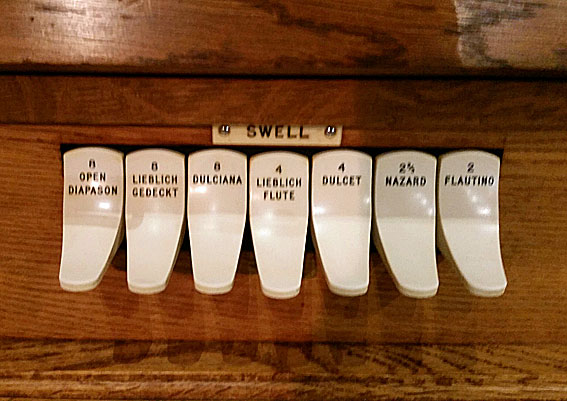
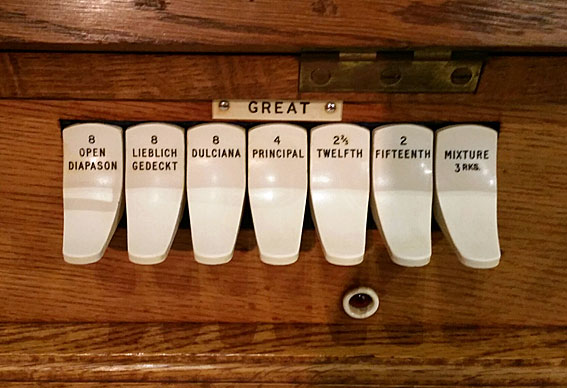
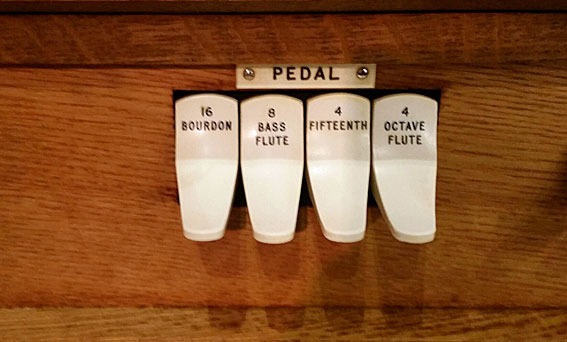
Photos: Ian Brown [March 2017]